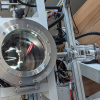Production of nanomaterials for hydrogen technologies
Technology description
| The name of the technology: | Production of nanomaterials for hydrogen technologies |
|---|---|
| Challenge: |
Hydrogen technologies represent one possible path to a carbon-free economy and clean energy. These are mainly electrochemical processes that allow the use of hydrogen as an energy carrier for the production, storage and generation of electricity. Electrocatalytic materials, typically in the form of nanostructures of metals and their alloys, are essential for the efficient operation of electrochemical processes. In the case of the hydrogen fuel cell, for example, it is estimated that around 40% of the cost of their production consists of so-called catalytic layers composed of platinum nanoparticles and is therefore naturally one of the areas where savings are sought. The currently used industrial method of preparing catalytic layers for hydrogen technology requires the preparation of the catalyst by the so-called wet route (sol-gel,). These processes involve a number of chemical reagents that are often hazardous to the environment. |
| Description: |
The Institute of Thermomechanics has developed a device using the spark ablation technique to synthesize metal nanoparticles below 5 nanometers in size. The technology enables the uniform deposition of functional layers of nanoparticles with thicknesses of several units to tens of micrometers. These layers are characterised by the high purity of the nanoparticles contained. By controlling spark synthesis parameters such as electrode material, frequency and energy of spark discharges, carrier gas composition, the composition of deposited nanoparticles can be purposefully varied. Synthesis by spark ablation is a simple gas-phase process that results in high purity of the produced nanoparticles and a low proportion of waste by-products compared to traditional wet (sol-gel) approaches to nanoparticle synthesis. The synthesis is carried out under atmospheric pressure, so there is no need to use vacuum systems as in PVD/CVD or magnetron sputtering techniques. The process is continuous, reproducible and scalable by increasing the spark frequency or by using multiple spark ablation units in parallel. The process parameters can be adjusted to accommodate the size of the nanoparticles and their composition in case mixed nanoparticles (nanoalloys), e.g. Pt/Ru, are synthesised. The generated nanoparticles are directly deposited in the gas phase into highly porous, uniform functional layers with a micrometer thickness, which significantly reduces the complexity of catalytic layer fabrication, its time and production cost for use in hydrogen fuel cells and electrolyzers. |
| Commercial opportunity: |
• hydrogen technologies - fuel cells and electrolyzers • optimization of the structure and composition of the catalytic layer for electrochemical devices • catalytic synthesis • spectroscopy • supercapacitors • gas sensors • research and development |
| IP protection status: | PCT přihláška číslo PCT/CZ/2022/050105 |
| Development status: |
Phase 2Corresponds with TRL 3 and TRL 4 Feasibility study. There is a realistic design of the technology and the initial tests in the laboratory are leading to the specification of the technology requirements and its capabilities.
|
| Partnering strategy: | Collaboration investment spin-off |
| More information: | We are in the process of establishing a spin-off company whose clients will include companies integrating our catalytic layers into their own products, e.g. hydrogen fuel cells, electrolyzers, and in general research teams interested in developing and optimizing catalyst nanomaterials (size and composition) and functional layers made from them (porosity and microstructure) for various electrochemical processes. |
| Images: | |
| Categories: | Nanotechnology Mechanical Engineering |
| Owner of a technology: |


